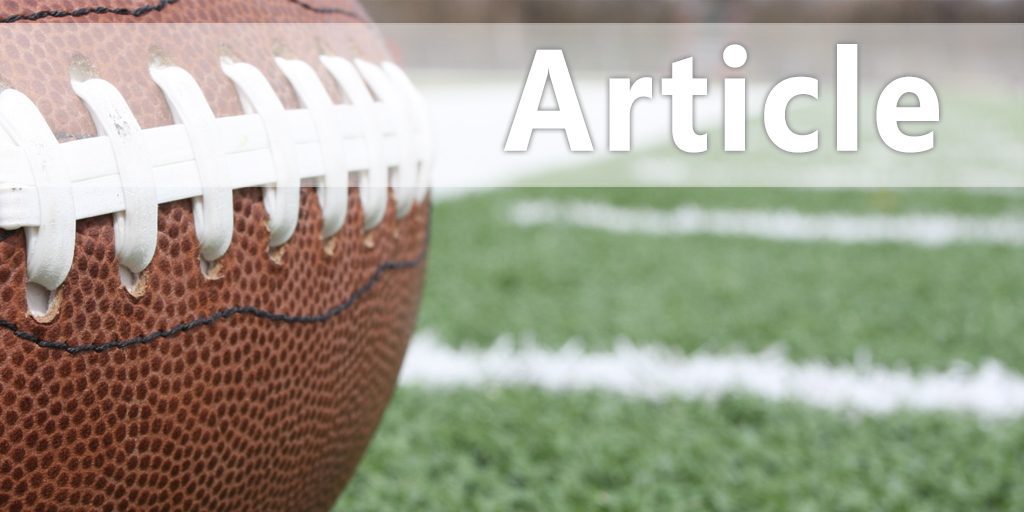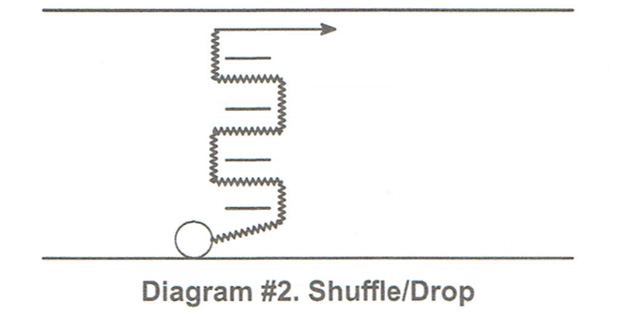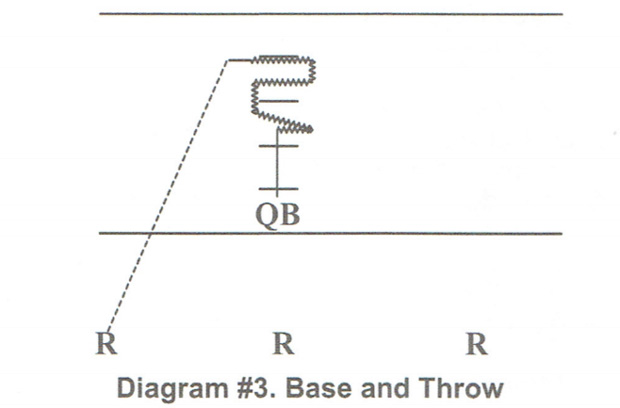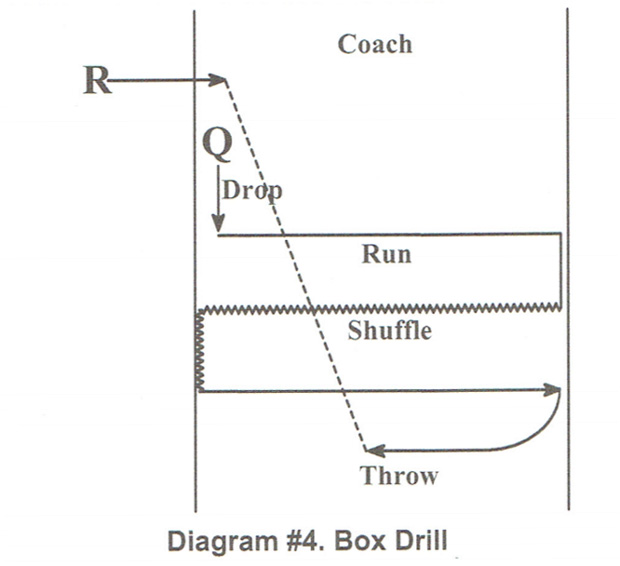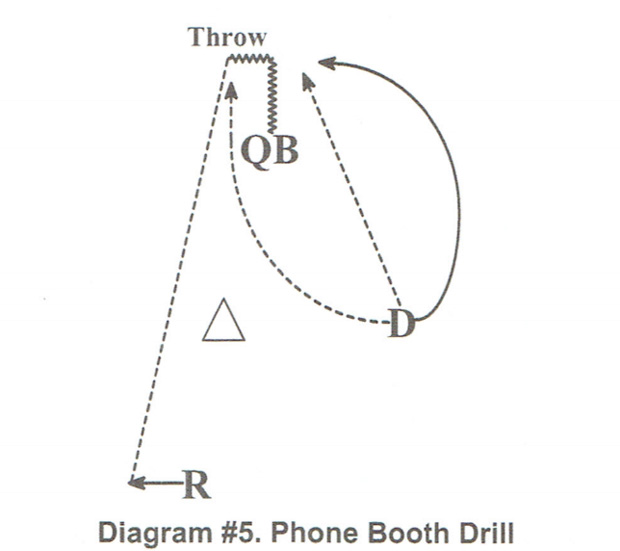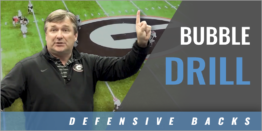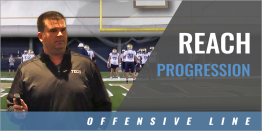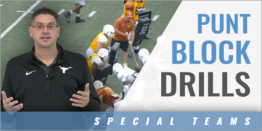| Developing the Young Quarterback |
| By: John Tomlinson - Cedar Hills High School (TX)
Originally Published in: Nike Coach of the Year Clinics - by Earl Browning Provided by: Nike Coach of the Year These are the topics I will cover today. • History and facts • Mental expectations • Fundamentals • Drills, examples, and concepts • Things to consider I want to cover some history and facts about the quarterback position. The mental expectation the players must have to play this position. I am going to talk about fundamentals, which are definitely important to you coaches. I have drills I am going to show you on video. At the end there are some things I want you to consider. I want to show you some pictures of quarterbacks. You should know who they are. There is Sam Darnold starting quarterback at Southern Cal, Jalen Hurts starting quarterback at Alabama, and Trace McSorley starting quarterback at Penn State. I have worked a camp where Jalen Hurts participated. He is from Texas. When I was in Virginia just before coming to Texas to coach football, Trace McSorley was up there in a small town called Ashburn. He was in the 8th grade and was unbelievable as a competitor. What prepared these young players and got them ready to play at this level? All these guys are young quarterbacks. They are all starting quarterbacks. The training of all these guys started with the high school coaches. This is not something they will get from a private training. They get it from their high school coaches. That is no disrespect to the professionals that train quarterbacks, but it starts with the high school coach. You have to have a plan in place. Dak Prescott fits into this category as well. If you look at what he did at Mississippi State and in pro football with Dallas this year as a young quarterback he was phenomenal. Here is something to think about. Of the 72 quarterbacks that signed with Power 5 programs in 2013. 59 did not finish their career with the team they originally signed with. That class experienced an incredible amount of attrition in one form or another and should have been key contributor at this stage in their career. ESPN That is an astounding number. But here are some additional facts. The Numbers Do Not Lie CBS Sports researched the top five quarterback signees... both dual threat and pro style since 2010 as ranked by 247Sports: • More than 40-percent of those players (24) transferred at least once. Just over half (30) started at least one game, but still four of the 30 eventually changed position or gave up the game because of physical injury. • Only 17 of the 59 signees from that group became what would be called established starters without either transferring or changing position. • Only two became All-Americans and only one won the Heisman Trophy, Jameis Winston. • In way of comparison, in the previous six years (2004-09) 75-percent of those quarterbacks at least became part-time starters. Slightly more than one third of the group transferred. There is a problem shown in those statistics. "Now days, these quarterbacks are getting four and five star egos. They are getting their heads blown up by the recruiter telling them they can play right away." Oklahoma Quarterback Baker Mayfield That is an issue right now in college football. I want to show you some pictures. The picture showed a grade school football player being abused by his coach who is screaming at him. Another picture shows a high school player with his head hung, while his parents argue in the background. There are Friday night youth league coaches, that lose their minds at games and the young players are the ones that suffer. Simple math tell us if you take the abuse plus the anger, it is spousal abuse, depression, or extreme loneliness. It does not have to be that way, but it can happen easily. The way you coach is either adding to or taking away from the anxiety the player feels. Think about that because it is important. In the position of quarterback temperament is everything. That takes into consideration about how you approach the player with your coaching style. I have been blessed to win a couple of championships but it is the process that gets you there. Here are some things I want you to think about. I am not intending to show any disrespect to anyone in this room. Do not take this personal. Coach's Reminders in Building a Young Quarterback • Remove yourself - you do not play anymore • Avoid "daddy ball" be inclusive, and not exclusive • How can you build him? Show him power and not strength • See no talent, develop the talent, get the nectar out of the fruit • Be the uncle, most likely "daddies" at the high school, offers not coming now • Identify the skills he has now, refine what you can • Create mental expectations, show leadership • Teach physical fundamentals, commit to it, do not deviate Avoid "daddy ball" and get all the players involved. How you treat the players is critical. Every day when you come out to practice, ask yourself, "How can I build him?" Show them power and not strength. There is a huge difference between those two things. Show them power by being mature with a good temperament, and show them what a good father you are. Show him that because he needs those things. These things are not necessarily just for the quarterbacks. It is for all your players. If you see a talent, develop it. Do not burn them out. If you see no talent, develop the talent. I want to tell you a story about no talent. At Cedar Hills, we have a receiver that plays at Ole Miss and a running back that plays for Southern Cal. We have two freshmen teams and two JV teams. The White teams at each level are the lower skilled players. These are the kids that are just agile enough to put the uniform on but have a desire to play football. The Red teams are the higher skilled young players. Those scholarship athletes that signed with Ole Miss and Southern Cal, both started on the freshmen White team. You have to be patient with your young players. Some of them are not going to mature until later in their high school career. Work with them and develop their talent. Get the nectar out of the fruit. Unless you are the coach or a trainer, you are not going to have much time with your son. That is going to be left to the coaches. If he runs well, teach him how to develop as a passer. He is already a runner. At the high school level he may just be getting by on athletic ability. That will not be enough at the next level. You must develop him into something he is not now. Improve his fundamentals and make him a better player. Leadership Expectation • Confidence • Unselfish • Mental toughness • Character • Hard working...Meritocracy (earned not entitled) • Body language • L.E.A.D. (Listen every time and digest) Hard working is essential in developing a quarterback. Make him earn everything. With today's youth, they all feel entitled. Do not do things for him because he is the quarterback. If he did not earn it he does not get it. I heard Tony Romo use the term "meritocracy." He used that term in reference to Dak Prescott remaining the quarterback at Dallas. He said that Dak should remain the starter after he recovered from his injury because he had earned it. We put it on our wall in the coach's office. This is not Entitlement State University. That goes for everyone on the team. Body language is important. These players are kids and they get down on occasion. However, we have to teach him how not to get down so everyone else can see. Once the quarterback is missing in action, it is a wrap. Unless you have a running back that can catch snaps and take it to the house, it is going to be tough. I know all you guys in here know all about these things so I am not going into too much detail about them. I have been blessed and I have been developing quarterbacks for a while. You cannot have a player that is "ankle deep." This is the kid who does not come to practice all the time and can barely tie his shoes. These are the kids that do not belong. You do not need a "knee deep" player. He is the player that is there sometimes and not there at other times. He is a below average teammate. You do not need a player that is "waist deep." That is a player that gives you 50-percent. Some days he works hard and other days he does not. He is very inconsistent. The player you need is the player that will submerge himself in everything you do. It is easy to find those types of players from day one. The quarterback is the catalyst of the team and you need to know his level of commitment. Is he ankle, knee, waist deep, or totally submerged? These are non-negotiable fundamentals. Ball protection • Secure the ball in both hands on the snap, the shotgun snap is just as important as having the bottom hand pressure in the traditional under center snap; We cannot run a play without getting the snap; Your eyes should be focused on the archway between the center's legs; You must have Christmas gift hands and wide eyes before the snap. • Front hand pressure - from the drop to set up in the pocket, I want front hand pressure on the ball. He only separates his hands when he is going to throw the ball. The quarterback has to maintain a stable front hand on the ball for protection • Open field - still two hands on the ball. Protect the ball in the open field like a running back. If you see green grass, take off and run the ball. Make sure you protect it with two hands on the ball. Remember the pressure points on the ball (Pec, forearm, thumb and index finger, and middle finger side open field). With these fundamentals it does not matter whether you are under the center as in the wing-T or in a shotgun set as we are. If you are under the center, you want the bottom hand pressure against the center's butt. Lift the center with your hands. We are never under the center. In the shotgun snap, I emphasize the quarterback watching the archway between the center's legs. You want Christmas hands and wide eyes. Christmas hands are like your kids opening presents. That is another way of saying active hands. We want to focus on the archway and have active hands. If the quarterback is not concentrating on the archway, he may get hit in the chest with the ball. They need to focus because there is nothing more embarrassing than to fumble the snap. When the quarterback gets the snap, I want front hand pressure on the ball. When they drop to throw, if he is a right-handed passer, he grips the laces with his right hand. The left hand is on the front of the ball and the carriage of the ball is over the right chest muscle. We have a drill, which emphasizes that point. When they drop, I try to knock the ball out of their hands. Quarterbacks for some reason as soon as they get into the second level, want to display the ball and carry it like a loaf of bread. You know when we play a good team that ball is coming out. You have to emphasize that in practice and talk about it. If you do not talk about carriage of the ball, when he fumbles that is on you. Here is what I wanted to talk to you about. There are seven things that are essential for throwing the football. PILLARS OF PASSING MECHANICS Fundamentals When evaluating the fundamental approach for a quarterback, here are the major components: • Grip Pre pass • Wrist Pre pass • Eyes Pre to post • Elbow Zero position • Transition Hinge, drive, hallway separation, turn, elevate • Base Pre pass • Extension These are the things that are vital and many young quarterbacks do not get it. The first thing is grip, which is a pre pass function. The hand size of the player will change over time. (Diagram #1) That is something you will have to constantly work on. The eyes are a pre snap to post snap function. The base is their feet and the extension is their arm extended to the target.
Grip Fingers • Your grip on the ball will vary according to your hand size. Every finger has a purpose and a positioning on the ball • Fingers slide with laces on pre pass • Pinky finger behind the laces, sliding between the digits and the tip of the ball • Ring finger along the laces • Middle finger off laces toward the back of the ball or against the laces if you have big hands • Index finger off lace toward back with the first knuckle along the stitching that aligns with the laces; ensure nice even bend of index finger to create a tight spiral (Grip Note: make sure all four fingers are in complete contact with the ball) • Thumb side - Thumb location is vital; the palm pocket is formed by the location of the thumb during the grip; if you slide the thumb down toward the tip you create a palm pocket. If you slide the thumb up the ball you lose the pocket; the thumb is aligned with the middle finger on the other side of the ball. (Thumb Note: Nose of the ball is in a slightly upward position when the thumb is positioned correctly.) When the quarterback is progressing up through the levels of football, the size of the ball will change from smaller balls to regulation sized balls. If you have a big handed youth player, you need to check with the league to see if you can use a bigger ball. The palm pocket is the space between the palm and the ball. The ball does not sit in the palm of the hand. There is air between the ball and the fingers. That is the fingertip control of the ball. The thumb should be parallel to the strip on the ball or on the strip. That gives the ball a slight upward tilt. If you move the thumb up the ball, it tilts the nose of the ball down. The index finger cannot be too high on the ball. If it is too high the quarterback will push the ball out of rotation. The index finger is the last finger to leave the ball and has to do with the tightness of the spiral of the ball. There are two fingers that should touch the laces. The middle finger and the ring finger. The pinkie is behind the laces. If you look at the football it is stitched together with four panels. That stitching gives you four long stitches on the ball. You hear coaches all the time when talking about getting the ball out quickly, to just grip it and rip it. That is fine, but I coach the quarterback to feel the long stitch with his index finger. There are four of them on the ball, there is only one set of laces. He has a good chance of finding the long stitch with his index finger. When the quarterback sets his feet to throw, he can find the long stitch. I highly recommend you coach him that way. The ball I use in practice is a lace less ball. You can find them at sports dealers around the country. There is a dealer in Dallas we use. If the hand is too far down on the ball, it will come out of his hand with no tight spiral and the ball will be all over the place. Give a reference point to each finger. Teach them how to grip the ball. If you do not do it, I will have to teach them when they get to the high school level. Wrist: The positioning of the wrist are pre-snap and must be consistent; a curled wrist position weakens the finger grip and drops the nose of the ball. The cocked wrist • Strength the finger grip • Lengthen the wrist snap and increase ball speed • Reduce ball movement and loads the ball for strong release to target • Bring nose of ball up to the proper release point (Wrist note: Cocking wrist on pre-pass is the best place to practice cocked wrist) If the quarterback cocks his wrist, he increases the spin on the ball and it comes out of his hand with more accuracy. The cocked wrist gives you snap when you release the ball. When I coach the throw, I tell the quarterback to extend the arm by snapping the elbow followed by the wrist snap. They snap the elbow and then the wrist. The quarterback as he carries the ball into his drop, has the ball seated on his right pec muscle. He does not want to push the ball up around shoulder height. That is too high. At the lower position, he can be more natural in this drop and protect the ball better. It is a comfortable position. The next component in progression is eyes. Eyes • Always downfield, keep eyes on progression, scan pre-snap, read post-snap (Eyes Note: the opposite color around you is felt not looked at) His eyes should always be downfield. When I show you some of these drills you will understand. It does not matter what type of drill you are doing. Have some manager or extra player in the secondary holding up fingers that the quarterback must identify to the coach during the drill. That influences the quarterback to train his eyes to look at the progression. When the quarterback gets to the highest level of competition, he has to know how to handle the rush. He has to keep his eyes down the field. That is the only way to find a receiver, however, he has to have a sense of feel for the opposite color. When he feels the pressure, he has to leave the pocket. That is all taught in practice. The next component is the elbow. This is what we call zero positioning. Elbow • Zero positioning enforces vertical throwing releases by putting the elbow in an elevated position above the shoulder • The zero position is a 45-degree angle out in front and off the body • Zero position promotes maximum power from the triceps When we get to the throwing position, the arm is elevated into the L-position on the shoulder. The zero position has the elbow at a 45-degree angle. The tip of the elbow shoulder should be out in front and off the body. The elbow is positioned in front of the wrist. When the throw comes out we extend the arm and snap the elbow followed by the snap of the wrist. Quarterbacks big mistake in the setup is dropping the ball down before he intends to throw it. To throw the ball he has to return it to the position above the shoulder. If he is playing against a good defensive back, he will read the dropping of the ball and break on the receiver. That split second returning the ball to the throwing position is the difference between a completion and a break up or interception. He wants to get the ball up in the throwing position, rotate the elbow to bring the ball forward, and snap the ball as he throws. The next step is the transition of the throw with the feet. • Hinge - This is where the quarterback loads his back leg and begins to distribute the power from the plant foot, for a right-handed quarterback his right foot is his hinge foot • Drive - The quarterback drives out with his front foot into the target hallway • Hallway-separation - the subtle move from the drive into the hallway; that is where we simultaneously separate our front hand off the ball and put our front foot on the ground at the target • Turn - This is where we throw the front elbow down inside while the passing elbow gets to zero, during the turn is where we engage our abs using our core muscles to help with power on the throw • Elevate - This is where the quarterback brings the lead leg through while elevating on his turn into the target. The key with this move is not to lean into the throw. If you lean that causes you to pull down instead of extend out to the target, elevate your turn into the target driving off the plant foot. When the quarterback drives forward, his front foot lifts off the ground. When the foot comes off the ground the front hand comes off the ball. That is called separation. He returns the foot to the ground quickly and raises his body and stands tall as he transfers his weight from the plant foot to the lead foot. I know what I am doing looks mechanical because I am teaching in steps. When you film your quarterback you can see the flaws and good things he does. It all looks natural. But you must teach it in steps. In the turn the back shoulder starts to work its way to the target. You cannot throw a powerful pass without a good base. Base: Consistency in the throw is not possible without a good base. • Hips between heels • Balanced stance • Weight on balls of the feet • Natural base Having a good base is like a boxer. If he does not have good balance, he is going to be on the floor. I tell the quarterbacks that a good base is a balanced stance. We want the hips between the heels. If the quarterback's feet are too close together, the ball will sail and he has no power because he is off-balance. The last part in the mechanics is extension. • Extension: This is the finish point of the throwing hand out to the target. After extending out to the target, the hand will naturally finish below the waist outside your non-plant foot. If the hand finished above the waist that is an indication you slashed (possible side arm method) that comes from the quarterback not having his elbow to "zero." (Note: Reach out and touch your target with your hand on your throw.) When we work on these mechanics we work on a number of skills at the same time. In the drills, I have them drop, transition and throw. When they drop, I stand to the side of the tilt and try to knock the ball out. The quarterback is throwing to a target down field. At times I have a manager stand next to the target. The quarterback has to deliver the ball to the opposite side the manager is standing. The manager moves from side to side so the quarterback has to throw away from the defender in both directions. If we are on the game field, I use the hash marks. (Diagram #2) If we are on the practice field, I set up cones. I call this drill shuffle/drop. They are using the hash marks as alleys to step through and change direction. We move forward and backward throws off the hash marks. They have a ball and are working on keeping their base and ball security. I walk around the drill punching balls. We want no balls punched out of the quarterback's hands.
We work the next drill which is similar to the shuffle/drop. (Diagram #3) I have three receivers down the field. The quarterback works on the hash marks. I give him commands that indicates what type of footwork he should use. If I say "over" he has to step over the hash mark. If I say "shuffle" he moves in and out on a shuffle move. When I clap my hands, he throws the ball to one of the three receivers. He should have his eyes down the field and spot the receiver that puts up his hands to indicate the throw.
All I am working on is the base of the quarterback. He has to have the good base to throw the ball quickly and accurately. If he does not have a good base there is no power on the throw. I also have a coach that is moving around in the secondary giving hand signals of numbers. The quarterback has to call out the number. The pocket is not always clean, but the quarterback has to feel the rush and see down the field. We want to do multiple skills within the drills. We work on footwork, throwing mechanics, and accuracy in the same drill. We use something called the "box" drill. (Diagram #4) The player starts on the one yard line. He is going to work from one yard line to the next one. I give him commands to indicate what type of action I want to see. I start him out on "drop" and he has to execute a five step drop. Before he plants I give him the next command, which may be "run." In that case he runs to the next yard marker. If I say run again, he returns to the place he just came from. I can give him shuffle or other commands. When I say throw, he comes to balance and delivers a ball to the receiver, who runs across the field.
We work our drops in a simple pitch and catch drill. We align the receiver at the depth of the pattern. The quarterback works his quick game steps, his three and five step drops, and throws to the receivers. In the drill we are watching footwork and throwing mechanics. We start with 10 yard throws and back up to 15 yard throw. We have a "phone booth" drill. This where we get the quarterback to work in close quarters. (Diagram #5) We tell the quarterback if he has a hard rush from a big defender, the defender cannot stop on a dime. If he is coming from the outside, the quarterback wants to step up and the defender will run by him. We put a distraction dummy rushing the quarterback. The quarterback avoids the defender and throws the ball.
All we are doing is making the quarterback make slight adjustments in the pocket and throw the ball. We do the drill with a coach throwing a big ball at the quarterback's feet. The quarterback drops, the coach rolls the ball, and the quarterback must step away, and throw the ball. Where Should I Throw the Ball? • Hitch - Wide receiver's face to outside shoulder • Slant - Up field shoulder or number • Quick out - Up field shoulder to low and away from the defender • Fade - Up field shoulder to outside • Seam - Up field shoulder, trajectory depends on coverage • Curl - Wide receiver's face to top of the numbers • Come-back - Outside shoulder before break out of stem • Post - Up field shoulder, trajectory depends on coverage • Swing/bubble - Up field shoulder to face • Dig/crosser, (shallow cross) - Up field shoulder, slightly in front • Corner - Cover-2 outside shoulder, medium trajectory to green grass Cover-3 Outside shoulder high trajectory We run a concept drill. (Diagram #6) You can fit whatever concept you have in this drill. We have three quarterbacks throwing. All the receivers in the drill are getting a ball thrown to them. We put the starting quarterback in the middle and he throws the concept patterns. Whichever receiver he throws, the other two quarterbacks throw to the other receivers on their side.
After all the balls are thrown, we run down to where the ball was caught, set the ball, and run the next play. When we get to the end of the field, we turn around and go back the other way. Next I want to make sure you understand. If you want your quarterback to be a success at a young age, throw sprint outs and RPO's. Accelerated Vision Shot gun or pro set • Play action (sprint option, RPO) • Quick game (bubble, slant, screen, flat, go) • Defensive key Accelerate vision - Allows quarterback to process information, quickly by speeding up his decision making. How is it done? Makes his life easy, reduce information and overloads, focus on what he does best. In the Super Bowl, Tom Brady went nine for nine in the second half and he was reading one defender. He read the corner. If the corner bailed, he threw to the flat. That is accelerated vision. Give the quarterback one thing to look at. Here are the steps to success: • Cue: eye, camera, feet, finish • Routine: Daily drill working on eye placement, work on having consistent feet and base • Reward: Successful execution and completion I want to recommend a book, which I think will improve your coaching. It is titled The Power of Habit" by Charles Duhigg. "Repetition, Repetition, and Repetition" will help you master the little things. Inspect what you expect. This last thing is to "stay on the mountain." You cannot get your quarterback two levels up. Keep him calm at a consistent pace. Do not put your quarterback in the clouds and do not put him in the valley. You can do that if you stay calm with the quarterback. I appreciate your time. Thank you again. |
